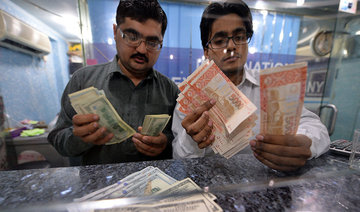KARACHI: The Pakistan rupee could face further pressure this week, in the midst of the country’s chronic foreign currency shortage and speculation of a third currency devaluation, analysts said.
The currency, which has been exposed to rising external financing requirements and lower remittances, touched 119.05 rupees to the dollar on Friday, closing at 118.70 rupees to the dollar on Saturday in the open market.
“People think that in coming days the rupee would be further under pressure due to increasing demand for the dollar so they start buying anticipating a dollar shortage,” Zeeshan Afzal, executive director-research at Insight Securities, told Arab News.
“Perception and real need (demand) drives the currency exchange market in both ways,” he said.
The rupee has been impacted by Pakistan’s historic high current account deficit of $14 billion that has widened because of increasing imports, insufficient exports and workers’ remittances.
“In Ramadan, the inflow of remittances has declined, demand for dollar from those going for Umrah has increased,” Muzamil Aslam, senior economist and CEO of EFG-Hermes Pakistan told Arab News.
Ratings agency Moody’s Investors Service last week forecast that the rupee could weaken to 125 to the dollar by June of next year.
The country’s central bank has already let the currency decline by 10 percent against the dollar in the past six months via devaluations in December and March.
Demand for dollars usually comes from general public, investors and importers, said Afzal.
“As our imports are more than our exports and other foreign exchange inflows, the pressure on US dollar (reserves) keeps mounting,” he said.
FASTFACTS
Pakistan's current account deficit has reached a historic high of about $14 billion.
Pakistan is also taking steps against money laundering as part of its international commitment to combat terror financing, ahead of a meeting of the Financial Action Task Force meeting in June, when Pakistan will be greylisted.
As part of the measures, State Bank of Pakistan recently directed currency exchange companies to maintain records of identification documents of customers for all foreign currency transactions worth $500 or more, in line with similar thresholds in other international jurisdictions.
“The move of State Bank of Pakistan is aimed at documenting the transactions in order to discourage terror financing,” said Afzal, who added that such requirements had little impact on exchange rates.
But foreign exchange dealers have claimed that lowering the transaction threshold for identification requirements from $2,500 to $500 has negatively impacted business.
“Our daily surplus supply of dollar was around $3 million per day until a week ago, when the central bank’s measures were not enforced,”,Malik Bostan, president of the Forex Association of Pakistan, told Arab News.
“Now the supply is now down to only $1 million per day as currency exchange business has shifted to unregistered dealers.”
“There are around 30,000 unlicensed currency dealers all over Pakistan,” he claimed, adding that the majority of buyers and sellers do not want to share their identification and choose to go to unregistered dealers.
“We have asked the central bank to come up with necessary laws to protect registered currency dealers,” Bostan said.
“Despite facing adverse business situation we have assured our support to central bank to take whatever steps are needed to get the Pakistan off the grey list of FATF.”
He said that the pressure on the dollar was unusual in the month of Ramadan when dollar inflows typically rise.
























